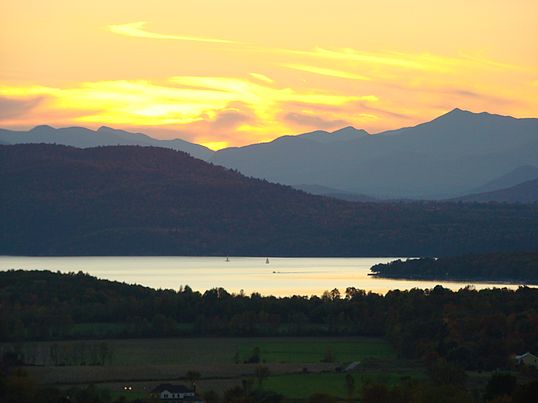Electric Transmission and the Lake
August 2015

On July 17, 2015 a transmission development company, TDI, announced a series of agreements with Vermont regulators that smooth the way for an electric transmission line that would run underneath Lake Champlain from Alburgh to Benson. The Lake Champlain region would serve only as a conduit for the electricity with the ultimate user being southern New England. Earlier, New York State officials approved a similar line proposed by the same company to deliver electricity to New York City. Since the electricity in these two lines will not be used by the region through which it passes it is fair to turn a skeptical eye to the transmission projects.
The electricity the lines will carry will be generated by Hydro Quebec, and offers both costs and benefits. The dams Hydro Quebec has constructed to generate electricity have inundated hundreds of square miles of land and submerged Native American communities. When some of these dams were proposed there were numerous organized efforts to protest their construction.
However times have changed. Global warming is a larger environmental concern today, and the electricity from Hydro Quebec will offset more carbon intense forms of generation, particularly natural gas. Meanwhile, Hydro Quebec reached an agreement with the Cree tribes that inhabit lands submerged by the dams, offering them $70 million over 47 years. As UVM history professor David Massell noted in a VPR interview, “What was sort of a cause celebre for New England environmentalists in the late ‘80s and early ‘90s just can't be any more if your aboriginal allies have fallen away, if they've signed the piece of paper.”
There are a few in-lake issues that need to be considered with regard to the transmission lines. Installation of the line will cause sediment resuspension, however that sediment should settle back to the bottom in a relatively short period of time. The cable itself will not result in the addition of nutrient pollution.
Electromagnetic fields generated by the operation of the cable could impact fish and other aquatic life; however in filings with the New York Public Service Board the environmental groups Scenic Hudson and Hudson Riverkeeper concluded such effects would be minimal. They noted that the burying the cables will block any field generation, that fields diminish exponentially as you move away from a cable, and that fish can move to avoid the fields.
TDI, the company that has proposed both Lake Champlain cable projects, recognizes that there are irrevocable impacts that their projects cause. To address those problems they have offered environmental mitigation funds that would finance alternative remediation work. For the line that runs to New York City, the fund would provide $177 million to be divided between the Hudson River and Lake Champlain. For the line on the Vermont side of the lake they offer $263 million for cleaning up and improving Lake Champlain and its tributaries and $109 million for a state renewable energy fund.
Hydro Quebec has electricity, and the cities of New York and Boston want it. There are other competing proposals for how to match up the producers and consumers here. For example, the Department of Energy recently finalized an Environmental Impact Statement for the Northern Pass project which would bring electric transmission lines through the White Mountains of New Hampshire to Boston.
Overland transport of electricity would have significantly more environmental impact than placing a cable at the bottom of Lake Champlain. Overland transmission disrupts scenic vistas, creates edge habitat that fragments otherwise wilderness areas, and requires much more soil and forest disturbance. Impacts on scenic vistas can be mitigated by burying the transmission lines, but burying doubles the cost of the project, and does not address issues of forest fragmentation and soil disturbance.
All major infrastructure projects involving some disruption. The question is always if the benefits of the project outweigh the disruption. In the case of power lines under Lake Champlain it seems they do. The alternative of overland transport of electricity would be more disruptive. Meanwhile, the company involved is willing to invest resources in alleviating other Lake Champlain problems.
Lake Look is a monthly natural history column produced by the Lake Champlain Committee (LCC). Formed in 1963, LCC is the only bi-state organization solely dedicated to protecting Lake Champlain’s health and accessibility. LCC uses science-based advocacy, education, and collaborative action to protect and restore water quality, safeguard natural habitats, foster stewardship, and ensure recreational access.
Get involved by joining LCC using our website secure form (at www.lakechamplaincommittee.org), or mail your contribution (Lake Champlain Committee, 208 Flynn Avenue - BLDG 3 - STUDIO 3-F, Burlington, VT 05401), or contact us at (802) 658-1414, or lcc@lakechamplaincommittee.org for more information.